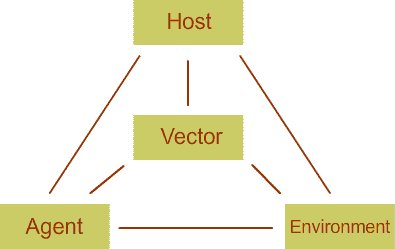


Epidemiology: Disease Detectives
Basic Concepts
An Introduction to Epidemiologic Thinking
The first major mistake that people make when they first associate with epidemiology is that "its just common sense". This study is more than just "applying common sense". There are specific calculations and concepts that one must understand in order to develop conclusions, verify hypotheses, or even something as "simple" as comparing data.
1. Agent: It is usually referred to as the pathogen, microorganism (including bacteria, parasite, or other microbe), or virus that results in the occurence of a disease. Additionally, there are a few factors that may affect whether or not a disease will occur, some of which include the pathogenicity ("ability to cause disease") and amount of exposure.
2. Host: The host is usually referring to the person that can aquire the illness. Some activities that increase chances for exposure are: hygiene, age, gender, sexual practices, and health condition.
3. Environment : The environment is a word usually used to describe external factors that affect the agent and therefore the exposure the host receives.
It is important to understand that in order to prevent or stop a disease, this triad needs to be broken.
The Epidemiologic Triad


Specific Example for using the triad. [Citation 35]
Steps of an Outbreak Investigation
The steps of an investigation taken direcly from the Center of Disease Control and Prevention Website:
1. Prepare for field work
-
prepare for scientific/investigation-type problems and management/operational issues
2. Establish the existence of an outbreak
-
Verify that the cluster (or an "aggreggatin of cases in a give area over a particular period of time") is an outbreak
-
This is usally done by comparing if the number of cases exceed the expected number the heatlh department usually receives.
3. Verify the Diagnosis
-
Review the clinical findings and laboratory findings
-
Consider visiting one or more patients to verify the diagnosis
-
Use frequency distribution (which is seeing how many people exhibited what symptom) to help "establish the credibility of the diagnosis
-
The frequency distribution is usually communicated in a table or chart and is usually the first thing seen in a report or manuscript
4. Construct a working case definition
-
Must contain three components:
-
a) Person: be specific and describe the KIND of person
-
b) Place: a location, facility, and must be as specific as possible
-
c) Time: be as specific as possible and describe the interval of time that is associatied with the illness
-
d) Clinical Critera: laboratory findings or clinical features of the illness
-
5. Find cases systematically and record information
-
Collect data about each cases
-
This includes: identification information, demographic, clinical, risk factor, and reporter information
6. Perform descriptive epidemiology
-
Summarize key points and characterize the outbreak over time
7. Develop a hypothesis
8. Evaluate hypotheses epidemiologically
9. Reconsider, refine, and re-evaluate hypothesis as necessary
10. Compare and and reconcile with laboratory and/or environmental studies
11. Put control and prevention measures into effect
12. Initiate or maintain surveillance (or watchful of the number of cases)
13. Communicate findings
Case Definition
A case definition is simalar to what one would describe as a criteria. Basically, it is the “set of criteria for determining who should be classified as a case”. Once an outbreak occurs, a case definition is made.
A case definition should include:
-
Clinical symptoms
-
Time: the time of onset of symptoms
-
Person: description of the type of people affected (gender, age, etc.)
-
Place: where the outbreak has occured or is occuring

Example of case defintion from the World Health Organization [Citation 39]
Agents of Disease
-
Metazoa: multicellular animals, many of which are parasites
-
-example of diseases: Trichinellosis (a disease caused by a roundworm transmitted through undercooked meat), hookworm (trasmitted through feces-contaiminated water/soil), and schistosomiasis (transmitted through contaminated water)
-
-
Protozoa: “single-celled organisms with a defined nucleus”; some can be parasites to humans
-
-example of diseases: malaria (transmitted through mosquitos), toxoplasmosis (trasmitted from cats and undercooked meat)
-
-
Fungi: “nonmotile, filamentous organisms that cause diseases that can be difficult to treat”
-
-example of diseases: Histoplasmosis (caused by inhaling dust contaiminated with bird feces)
-
-
Bacteria: single-celled organisms that lack a nucleus
-
-example of diseases: tuberculosis, staphlococcal disease (a disease that affects almost all the organs in the body)
-
-
Rickettsia: a type of bacteria usually associated with lice, ticks, fleas, and mites
-
-example of diseases: Typhus and Rocky Mountain Spotted Fever (trasmitted by ticks)
-
-
Viruses:"small, consists of RNA or DNA, and an outer coat of protein; it can only reproduce and grow inside living cells”
-
-example of diseases: Influenza, HIV, and rabies
-
-
Prions: “infectious agents that do not have any genes”; they are made up of protein and are able to replicate in an organism’s tissue
-
-example of disease: Crutzfeld-Jacob Disease (CJD)
-
Koch's Postulates
Koch’s Postulates are used to “identify the causative agent of a particular disease”. [Citation 41]

